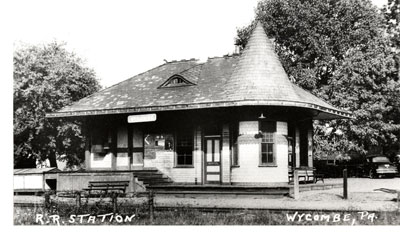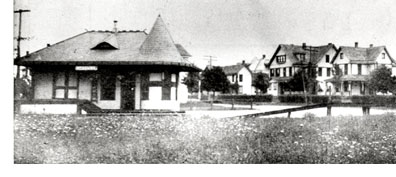The History
 Rudolph Cotter House Rudolph Cotter House
Excerpt from Historic Wycombe: Bucks County, Pennsylvania, by Mary Ann Sircely, who has lived in the Rudolph Cotter House since December, 1976:
"Cotter purchased the property in April 1901 and had John Larue build a house and a warehouse for farm machinery and fertilizer. The Victorian frame house has a wraparound porch with turned columns, straight fretwork brackets and turned spindle railing that protects an entrance on the projecting bay. The house was built to have a kitchen annexed, and water was supplied from a large tank located on the second floor. Cotter moved in on Jan. 9, 1902. The property was extended to an unusual T-shape after John Walton abandoned his plan to build another avenue of homes behind those on the Buckingham side of Township Line Road."
 Shortly after, the kitchen was added with a bathroom above. In 1910, Cotter and his wife, Anna R. Cotter, built the house next door for their daughter and her husband, Ada and John Noel. Shortly after, the kitchen was added with a bathroom above. In 1910, Cotter and his wife, Anna R. Cotter, built the house next door for their daughter and her husband, Ada and John Noel.
The next residents were Amos J. and Anna T. Kirk, whose niece related the following story: Her aunt, an English teacher at Doylestown High School, had Pulitzer Prize winning author James A. Michener as a student. Michener apparently thought so highly of his English teacher, he reportedly turned down a dinner invitation at the White House to attend her retirement party.
After the Kirks died, the estate rented the house for 10 years to the Allston family. The present owners, Harry and Mary Ann Sircely, purchased the property and moved in with four-month-old Matthew in late 1976. It was the beginning of many cherished years, raising three sons and enjoying the congenial Wycombe Village community.
 Wycombe Village Historic District Wycombe Village Historic District
Wycombe, nestled deep in the farmland of Bucks County, is a village of tree-lined streets, shady porches and idyllic charm. The village looks much like it did more than 100 years ago, preserving a fine example of a self-sufficient rural village of the late 19th century.
In January 1985, Wycombe was entered on the National Register of Historic Places, the official list of the nation's cultural resources worthy of preservation. A whistlestop town on the Northeast Pennsylvania Railroad Line, now the New Hope and Ivyland Railroad, Wycombe grew so fast that 46 of 59 structures in the historic district were built within 25 years of the opening of the rail line in 1891, and a self-supporting village resulted, uniquely uniform in its "Wycombe style" of construction.
|